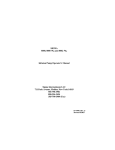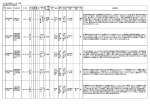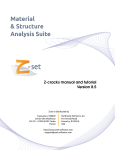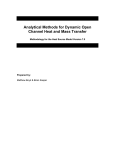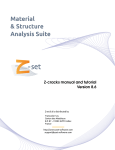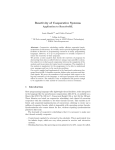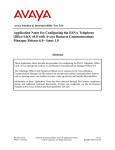Download Chapter 3 Algorithms Design
Transcript
Chapter 3
Algorithms Design
An exact algorithm that uses a branch and bound technique was implemented to solve
the set covering problem. Two polynomial algorithms were also designed and tested. In
this chapter, design of these algorithms will be presented. A DLV specification will be
presented in the first section. The exact algorithm will be explained in Section 3.2. Next
two sections detail main ideas about the polynomial algorithms. The first polynomial
algorithm uses a greedy approach and the other uses a dynamic programming technique.
Finally, in last section, some other details about implementation are explained.
3.1
DLV specification
In this section a specification of the problem using DLV is shown. DLV is a disjunctive
datalog system. It is useful to specify properties of a problem and to allow the inference
engine to solve it. NP complete problems are in general efficiently solved with logic
programming.
Some variables will be defined to explain the program. Let < X, F > be an instance
of the set covering problem. Let X be the set of elements, and F be a collection of
subsets, Si ∈ F where Si ⊆ X.
17
CHAPTER 3. ALGORITHMS DESIGN
18
First, it is need to define a range of constants that have the property of being subsets
of the set S, this is, the indexes of Si .
i subs(N) :- N>=1, number of subsets(X), N <= X, #int(N).
Then two subsets are defined, one of all the elements x ∈ X and the other of the
elements that have been already included in the solution.
tot1(X) :- in(R), s(R,X).
tot(X) :- i subs(R), s(R,X).
It is asked for the inclusion of a variable subset R in the solution, using a disjunctive
clause.
in(R) ∨ - in(R) :- i subs(R).
Then it is defined that there is no solution if all elements x are not included in it.
:- tot(X), not tot1(X).
Finally, the best solution is looked for, the minimum number of sets.
:∼ in( ).
It means that DLV has to look for a solution with a minimum number of predicates
“in”; in other words, with a minimum number of subsets in the solution.
This program is a small specification and it has many advantages. It is easy to
find mistakes on it, and it can be checked in efficiency and effectiveness against the
implemented algorithms.
The input has the next format:
s(S, E).
Where S is the number of subset, E is the number of element and s is the predicate
which means: E belongs to S.
Example 3.1. Let X be the set {a, b, c, d, e, f }. Let F = {S1 , S2 , S3 , S4 }. Let S1 =
{a, b, c}, S2 = {a, d}, S3 = {b, e} and S4 = {c, f }.
CHAPTER 3. ALGORITHMS DESIGN
19
This example is coded in DLV as follows:
s(1,a).
s(1,b),
s(1,c).
s(2,a).
s(2,d).
s(3,b).
s(3,e).
s(4,c).
s(4,f).
The output will be:
Best model: {in(2), in(3), in(4)}
Cost ([Weight:Level]): <[3:1]>
It means that sets S2 , S3 and S4 are an optimal solution with a cardinality of 3
elements.
3.2
Exact algorithm
An exact algorithm was implemented in C++. As the problem is NP complete, there
are no different complex algorithms. An algorithm with a general branch and bound
is used to solve set covering. It is outlined in [23]. This strategy assures the exactness
of the algorithm. A recursive strategy is used in order to reduce the complexity of the
implementation.
The main idea of the algorithm is to eliminate a set and recursively find the minimum
size. Later, it adds this set to the solution and gets the minimal size. Both sizes are
CHAPTER 3. ALGORITHMS DESIGN
20
compared and the function returns the set with the best solution.
It can be shown that this algorithm is Θn2 . The time grows exponentially; consequently, the time to solve a big input will be excessive. In order to reduce it some
strategies are used to avoid recursive calls to the function.
The first prune is to determine a starting maximum bound with the help of a
greedy approximation algorithm in order to follow only those branches that promise
better results. This bound is updated as soon as a better solution is found during the
run.
Also, on each iteration, two intuitive pruning rules are applied. These prunes will
be explained below. They are used until no further pruning can be used. In this case,
recursion is applied.
The algorithm works as follows:
[fontadjust, mathescape] function (integer) setc over(collectionXi, collectionwitness, setpartials et,
uniquee lementp rune(Xi)doXi← Xm odif ied; Xm odif ied← subsetp runing(Xi); Xi← Xm odif ied; Xm o
uniquee lementp rune(Xi, partials et, witness); while(Xm odif ied <> Xi)
//set Selection set Si ← selecteds et(Xm odif ied);
//Eliminate the set from the list of missing sets Xi ← Xi Si
//Add the set and check if solution is found partials et = partials et∪ Si if(S ⊆
partials et)returnpartials ize + 1;
//Find the best solution without this set size1 ← setCover(Xi, partials et Si, S, partials ize)
//Find the best solution with this set partials ize← partials ize + 1if ((partials ize +
1) > maxSize)size2← setc over(Xi, witness, partials et, S, maxSize, partials ize)
if(size2 ¿ size1) witness ← witness ∪ {Si } return size2 else return size1
The functions subset pruning() and unique element prune() are explained in
Sections 3.2.1 and 3.2.2 respectively.
The function selected set() selects a subset to be proved. This set can be selected
CHAPTER 3. ALGORITHMS DESIGN
21
by different strategies: randomly selected, the first one or the last one of the list. It can
use a more sophisticated strategy; for instance, the set that has more elements or more
intersections with other sets. In the implementation the first set of the list is selected.
A more sophisticated strategy was not implemented because exact algorithm is going
to be used for small inputs.
First of all, a function that gets the greedy solution of the problem is called. The
function returns a bitmap array of the selected sets. Actually, all the implementations
use a bitmap array to present the solution. The reason for this is that it is easier to
check whether a set is inside the solution, outside the solution, or just has not been
processed. Other advantage is that the positions in the array, representing the sets, can
be directly accessed; there is no need of a sequential access.
Greedy function returns a number representing the maximum cardinality of the solution. The recursive function uses this size when it adds a new set, knowing beforehand
which branches have not optimal solution.
The recursive function previously outlined receives the following parameters:
• Sol. It comes from solution. A value of 1 is set in this variable if the function got
a solution in this iteration.
• Next. It is a pointer to the next subset that has not been processed in the
solution.
• Bsets. Bitmap of subsets. These are arrays where the best solutions are saved.
It has an efficient access to any position.
• Subu. Union of subsets that has been already included in the solution. It will
help to avoid recursive calls when a solution has been found.
• MaxS. Maximum size of the solution. Since in the second part of the algorithm
CHAPTER 3. ALGORITHMS DESIGN
22
a set is added to the solution, this bound has to be checked in order to reduce
some recursive calls. When a better solution is found, this bound is updated.
• Size. It has the cardinality of the partial solution in this iteration.
The output of the function is the minimum size found, taking the partial solution
as described before.
3.2.1
Subsets pruning
It is explained now how this pruning rule works.
Lemma 3.1. Let < X, F > be an instance of set cover. Let Si and Sj be subsets of
the base set X. This is, {Si , Sj } ⊆ F . It can be shown that if Si ⊆ Sj then Si can be
eliminated as if it were not part of an optimal solution. This is because if Si were part
of any solution, there would be other solutions equal or better with the subset Sj . Proof
of this is trivial.
Corollary 3.1. Let C 0 ⊆ F be a collection of subsets which are necessarily added to
the solution. Let X 0 ⊆ X be the set of elements covered by C 0 . Notice that this is not
exactly a set covering problem because there is a set of subsets which is fixed. However,
Lemma 3.1 can still be applied as follows: It can be shown that if (Si \X 0 ) ⊆ (Sj \X 0 )
then, again, Si is not part of the solution. The proof of this is similar to a proof of
Lemma 3.1.
It is important here to remark that this does not mean that S1 could not be part of
an optimal solution. Therefore, if all the optimal solutions are serached, follow a path
where S1 is part of the solution, is needed. For example:
Example 3.2. Let < F = {S1 , S2 , S3 , S4 }, X = {a, b, c} > be an instance of set
covering. It is defined S1 = {a, b} , S2 = {c} and S3 = {b, c}. There are two optimal
CHAPTER 3. ALGORITHMS DESIGN
23
solutions: C1 = {S1 , S2 } and C2 = {S1 , S3 }. However, cardinality of the best solution
can be found eliminating S2 because it is a subset of S3 .
This prune is implemented using a simple cycle for each set remaining in the list
of unprocessed sets. For every set not added to the solution, the algorithm will select
subsets of the set and will add them to the list of subsets that are not in the solution.
The function uses the same parameters explained in the previous section.
3.2.2
Unique element subset
This pruning rule adds necessary subsets to the solution.
Lemma 3.2. Let < X, F > be an instance of set cover. Let S1 and S2 be subsets of the
base set X, {S1 , S2 } ⊆ F . Let x ∈ X be an element of the base set. Let, furthermore,
x ∈ S1 . If there is no subset S2 such that x ∈ S2 and S1 6= S2 , then can be said that
S1 is necessarily part of the solution in this branch, because x must part of the union of
subset which will be covered by the solution. The proof of this is also trivial.
A corollary is defined as in the previous section:
Corollary 3.2. Let C 0 ⊆ F be a collection of subsets which are necessarily removed from
the solution. Let X 0 ⊆ X be the set of elements covered by C 0 . After this restriction, the
algorithm could have “unique elements” which belong to only one subset of the remaining
subsets in F. The same rule of Lemma 3.2 can be applied to these subsets. A proof of
this is analogous to a proof of the referred lemma.
The corollaries give the possibility of applying the pruning rules at any level of the
algorithm, as it was defined in the exact algorithm proposed in the beginning of Section
3.2.
The algorithm used for this pruning rule is presented here:
CHAPTER 3. ALGORITHMS DESIGN
24
[fontadjust, mathescape] uniquee lementp rune(collectionXi, setpartials et)U ← ∅ U2
← ∅ For each X ∈ Xi R ← X partials et//Step1U ← U R // Step 2 R ← R U2 //
Step 3 U ← R ∪ U // Step 4 U2 ← R ∪ U2 // Step 5
Lemma 3.3. Let n be the number of elements. If the algorithm is applied to every set
Si ∈ Xi, it can be proven that at the end of any iteration, U 2 is the set of all elements
which appear at least once. Moreover, U is the set of unique elements, elements that
have appeared exactly once.
Proof. It will be proven by induction over the cardinality of Xi.
Base case. Following the steps of the algorithm:
U ←∅
U2 ← ∅
1. R ← S1\∅; R = S1
2. U ← ∅
3. R ← R
4. U ← R; U = S1
5. U 2 ← R; U = S2
U and U 2 have the properties enunciated before.
An element X with different properties will be taken to demonstrate that properties
remain.
Case 1. If X ∈ U , and X ∈
/ R, then X is unique, so X must be in U and U 2 at the
end of the iteration.
X ∈ U . It can be seen that as X ∈
/ R, X ∈ U after steps 2 and 4.
CHAPTER 3. ALGORITHMS DESIGN
25
X ∈ U 2. If X ∈ U then, by hypothesis of induction, X ∈ U 2 in the beginning. U 2
is modified in step 5, however, no elements are removed because it is a union operation.
Case 2. If X ∈ U , and X ∈ R, then X is not unique, so X must not be in U at the
end of the iteration. It can be seen as in the previous case that X remains belonging
to U 2.
After step 1, X ∈ U , but after step 2 X ∈ U . X ∈ U 2 so X ∈
/ R by step 3.
Therefore, X ∈
/ U after step 4 and 5.
Case 3. If X ∈
/ U , and X ∈ R.
a) X is a unique element. Then X ∈ R until step 4. After it, X ∈ U , and by step
5 X ∈ U 2 too.
b) X is not a unique element, this is, X ∈ U 2. Then, after step 3, X ∈
/ R, so X ∈
/U
but X ∈ U 2, as it was supposed to be.
Now, it is necessary to find the subsets containing unique elements x ∈ U . These
sets will be added to the solution.
Pruning functions use also the parameters for exact algorithm. However, they use
two more flags:
• EndF. A value of 1 indicates that the brand has ended, this means that the
algorithm has found a solution or there is no solution.
• Sol. This flag indicates if there is or not a solution.
3.3
Polynomial Algorithm using a Greedy Approach
Greedy algorithm is one of the best polynomial approaches found for set covering. Its
approximation ratio is bounded by the function ln m − ln ln m + Θ(1). The following
CHAPTER 3. ALGORITHMS DESIGN
26
pseudocode is the general algorithm. The function cardinality(S) gets the number of
elements in a set.
[fontadjust, mathescape] Greedy-Set-Covering(set X, collection F) C ← ∅ while(C
6= X) max = 0 foreach Si in F do card = cardinality(Si ) if (card¿max) Temp ← Si max
= card /* The subset with maximum cardinality is added to the solution and remove
it from the collection of subsets */ C = C ∪ {T emp} F = F \ {T emp} return C
As it can observed, if the sets have the same size, greedy algorithm selects the first
set found. Therefore, it breaks ties with alphanumeric order.
The greedy algorithm was implemented to define a maximum limit of sets in order to
reduce recursion calls. The first implemented polynomial algorithm is a greedy variant.
It uses two different strategies, which will be explained throughout this section.
The first strategy is the use of an exact algorithm at the lower level. It increments
the exactness of the greedy at the end, where more ties can be found in the moment of
selecting the set with the highest cardinality.
Therefore, the general algorithm stays as follows:
1. Apply general greedy in order to find the minimal bound.
2. It is defined a minimum limit in order to call the exact algorithm.
3. If the limit is bigger than some constant k, apply a greedy strategy on each
iteration until this limit is reached. If it is not, go to the next step.
4. Apply the exact algorithm to the rest of sets.
Let n be the number of subsets obtained in the initial greedy. It is defined a constant
c0 = 2 × (log2 n). For example, if there are 500 subsets obtained, the exact algorithm
after c0 = 2 × (log2 500) is called; this is, 18 elements. In order to use improve exactness
of the algorithm, the constant c is defined as c = max(k, c0 ) where k is a number, the
CHAPTER 3. ALGORITHMS DESIGN
27
number of subsets, such that exact algorithm still finds the solution in a reasonable
time.
This constant was defined in order to conserve the property of the algorithm of being
polynomial, since branch and bound is exhaustive and Θ(2n ). Therefore, this algorithm
is Θ(n2 + 22×(log2 n) ) = Θ(n2 ), this is, n2 . Note that if the constant that multiplies the
logarithm is increased, the order (Θ) of this algorithm also increases. For example, if
it has 25×log2 n , the algorithm increases to Θn5 . Although it is still polynomial, it was
preferred to have at most the same complexity.
This approach improves the greedy algorithm solutions. However, it has, of course
some error margin compared against the exact algorithm. Hence, there will be presented
the second strategy used to reduce error in the polynomial algorithm. It consists into
taking pairs of sets instead of single sets on each iteration.
Let X be a collection of subsets Sn ⊆ S. Pairs of this subsets are selected, this is
< Si , Sj >. This pairs are elements of S × S. Greedy algorithm is applied over this
pairs. This means that it will select the pair with the highest cardinality until the set S
is completely covered. This algorithm also breaks ties using alphanumeric order. The
strategy of using pairs diminishes the probability of selecting a local best set. It is Θn4
(remember that greedy approach is Θn2 and combining all the subsets in pairs is also
Θn2 ). Intuitively, it gives a better warranty than greedy algorithm.
However, sometimes when the exact solution is an odd number, this algorithm has
some trouble on getting it, as a consequence of selecting one set instead of two. The
greedy algorithm there works better than greedy-by-pairs. The problem outlined can
be easily solved if both strategies are combined. In this way, there are no disadvantages
of using a greedy approach by pairs. Other strategy that can be used to solve this
problem is to check redundancy on sets, or use pruning rules. It helps if pruning is used
only the first time but some instances get worst solutions if the pruning functions are
CHAPTER 3. ALGORITHMS DESIGN
28
applied at every iteration.
3.4
Dynamic programming approach
The knapsack problem is one of the best solved NP complete problems. It is explained
and analyzed in [23]. There is an algorithm to solve it that gets the best solution in a
reasonable time for the average case. Problems of this kind are called semi polynomial
because they are polynomial according to other variables of the input. The algorithm
uses a recursive function when it is outlined. At this point, correctness can be checked.
This would represent a problem; however, the partial solutions of the function can be
calculated previously, converting the time of solution, from exponential to polynomial.
An algorithm using the same approach was designed to solve set covering. It is
defined with to variables, n and m, where n is the total number of subsets of a list,
and m is the number of subsets supposed to be minimal. The goal is to find a function
that maximizes the number of elements using m subsets. This function is similar to
that one of the knapsack problem. Whether the set is added or not, is decided in each
function. Let dsc be the function for the algorithm. Let card be a function that obtains
the cardinality of any set. It can be defined as follows:
0
if m = 0, or n = 0,
dsc(n, m) = max(dsc(n − 1, m)),
card (n ∪ dsc(n − 1, m − 1)) Otherwise
(3.1)
where function max is defined as:
max(a, b) =
a if a ≥ b
b
if b > a
(3.2)
CHAPTER 3. ALGORITHMS DESIGN
29
The problem is solved in polynomial time. However, there is an error bound over
the optimal value. One of the reasons, in addition to the NP complete nature of the
problem, is that the maximum value is not always precise.
This algorithm was first defined in XSB language. The complete set is defined:
seti(X,L) :- setof(Y, s(X,Y), L).
Then, the base cases of the function are defined:
setc(N,0, []).
setc(0,M, []).
Then, the recursive function is defined:
setc(N,M, Out) :- seti(N, S1), N1 is N-1, setc(N1, M,S2), N> 0, M> 0,
M1 is M-1, setc(N1,M1,S3), union(S1,S3,S4),
maxc(S2,S4, Out).
It means “Maximal output of N sets using M sets is Out. S1 is defined as the list of
element of the set N. S2 is defined as the elements of N-1; this is, when the set has not
been added yet. S3 is defined as the maximum set of elements until N-1 taking M-1
sets. S4 is the union of S1 and S3, this is, the largest set including N. Therefore, Out is
defined as the largest set between S2 and S4”. It can be easily mapped to the function
3.1.
It is important the definition of the function which gets the maximum between two
sets:
maxc(S1,S2,S1) :- length(S1, N), length(S2,M),
N == M.
maxc(S1,S2,S1) :- length(S1, N), length(S2,M),
N > M.
maxc(S1,S2,S2) :- length(S1, N), length(S2,M),
M > N.
CHAPTER 3. ALGORITHMS DESIGN
30
The sets operation of “union” has also to be defined:
union([],X,X):- !.
union(X,[],X):- !.
union([X|Y], Z, [X|W]) :- not member(X,Z), union(Y,Z,W).
union([X|Y], Z, W) :- member(X,Z), union(Y,Z,W).
The input is the same than in DLV program. It is defined as s(N,E) where N is the
number of set and E is the element belonging to this subset. XSB is a language that
manages queries. In this case, the query would be:
?
dsc(4,3,Out)
The output format is the maximum set found, which means that it is a list of
elements.
Out = { a,b,c,d,e }
However, this program is used only for some small examples, where the number M
of minimal subsets is known, or at least there is an approximate idea. The real program
is not that simple. It fills a table, using i, j as the parameters n and m are used in the
algorithm. The program stops when it is in the set N and the set saved in the table is
the same than universal set. The column j is returned as the result (M).
A table is used for saving the results. By the nature of the function, only the
previous line of results is necessary. Therefore, the table has only two rows and uses a
module 2 operation to access the rows. This has the purpose of saving memory space,
because sometimes the input can be really big. A complete table of the cardinalities is
used, however, in order to help in the recovery of the best sets defined in the solution.
The witness recovery is just a pointer to the matrix that backs down the rows. It
checks if there is any difference between two rows i and i − 1 of the matrix. If they are
different, it means that the row i was important and was included in the solution. It is
CHAPTER 3. ALGORITHMS DESIGN
31
important then to follow the correct path. The column to start is the column M, called
j, of the algorithm. For example, if the algorithm returns a best solution of 5 elements,
and the number of sets is 20, it starts jumping back and it stops when it arrives to the
first column.
3.5
General structure of the implementation
The software will be divided in different sections, with the goal of integrating these
modules and exchange them to do the proofs.
3.5.1
Methodology
To develop the software, a simple cascade method of software engineering consisting on
four steps was followed:
1. The first step was to analyze the problem. This is the shortest step because the
typing problem and the conversion to set covering had already been done. On the
other side set covering is a well known problem, and lots of literature about its
description, definition, and even algorithms and proofs can be found. This part
was outlined in Chapter 1.
2. The second part was to select out and design algorithms of those that have proven
to be good.
3. The third step was the implementation of the algorithms. These steps, 2 and 3,
are explained in Chapter 3.
4. Finally, they were tested. It was necessary to define the variables to be observed.
In this case, the most important parameters are time, size of input and exactness
CHAPTER 3. ALGORITHMS DESIGN
32
in the case of polynomial algorithms. There were two kinds of input. The first
one was the random input, generated using a program that creates instances
of set covering. The second type is input from a real database of instances of
typing sequences, which helps to validate the results and to observe how different
algorithms work on this kind of information.
There are different modules for the program. For example, it is important to have
modules for reading input, as its format could vary. There is also used a module for
set operations, like union and intersection. There is also a set of variables called ”state
of solution” defined for every iteration in greedy or in the exact algorithm. It is useful
also in prunes.
As the main program, there is a module that can call the algorithms once or many
times, in order to run many inputs and to work with them. The output is the running
time of the entries and some other statistics like prunes, ties (in greedy algorithm) and
some other stuff, useful to find some properties and conclusions of the algorithms. All
the algorithms and libraries were programmed in C++.
A library of set manipulation was taken from [2]. This library implements set
operations in a very efficient way. It uses bit level operations and logic operations. It
was used as a module of the system. The advantage of bit operations is that logic
operations, meaning set operations, increased the velocity of the set operations, crucial
for a good performance of the algorithms. The operations found in the library were:
intersect: Finds an intersection between two sets.
difference: Finds the difference between two sets.
unite: Finds the union between two sets.
add element: Adds an element to a given set.
remove element: Removes an element from a given set.
CHAPTER 3. ALGORITHMS DESIGN
33
clear set: Removes all elements from a set.
print set: Prints the elements of a set to the standard output.
isin: Tests if an element belongs to a given set.
Some other functions were added to the library using the same structure of char
array and bits:
cardinality: Finds the number of elements of a given set.
is empty: Tests if a given set is the empty set ∅.
subset: Tests if a set is subset of another given set.
copy to: Returns a set with the same elements than a given set.
As it the problem was designed using a structured approach instead of object oriented programming. The diagrams and Documentation the software can be seen in
Appendix A, where Data Flow Diagrams are presented, as well as function call diagrams and a class diagram. The class diagram only presents the general structure of
the software for it only shows how the libraries of the methods are used. User’s Manual
of the software is found in Appendix B.
3.5.2
Input and output of algorithms
The input read has to be transformed to a set of character arrays. Up to now it has been
implemented only in one format. First, two numbers are read: setsize and nof ssets,
the total number of elements, this is |X|, and the number of subsets. The sets are read
as pairs of numbers < x, y > where x is the number of set, 0 < x < nof ssets, and y is
the number of element, 0 < y < setsize.
The output is the minimal number of subsets found by the algorithm. The list
of subsets selected as part of the solution is also printed, this is, a list of numbers x,
0 < x < nof ssets, representing the number assigned to the subsets.

















